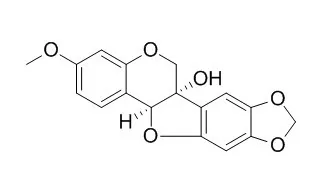| In vitro: |
| Molecules. 2014 Dec 23;20(1):24-34. | | EDTA a novel inducer of pisatin, a phytoalexin indicator of the non-host resistance in peas.[Pubmed: 25546618] | Pea pod endocarp suppresses the growth of an inappropriate fungus or non-pathogen by generating a "non-host resistance response" that completely suppresses growth of the challenging fungus within 6 h. Most of the components of this resistance response including Pisatin production can be elicited by an extensive number of both biotic and abiotic inducers. Thus this phytoalexin serves as an indicator to be used in evaluating the chemical properties of inducers that can initiate the resistance response. Many of the Pisatin inducers are reported to interact with DNA and potentially cause DNA damage.
METHODS AND RESULTS:
Here we propose that EDTA (ethylenediaminetetraacetic acid) is an elicitor to evoke non-host resistance in plants. EDTA is manufactured as a chelating agent, however at low concentration it is a strong elicitor, inducing the phytoalexin Pisatin, cellular DNA damage and defense-responsive genes. It is capable of activating complete resistance in peas against a pea pathogen. Since there is also an accompanying fragmentation of pea DNA and alteration in the size of pea nuclei, the potential biochemical insult as a metal chelator may not be its primary action.
CONCLUSIONS:
The potential effects of EDTA on the structure of DNA within pea chromatin may assist the transcription of plant defense genes. | | Mol Plant Microbe Interact. 2004 Jul;17(7):798-804. | | Introduction of plant and fungal genes into pea (Pisum sativum L.) hairy roots reduces their ability to produce pisatin and affects their response to a fungal pathogen.[Pubmed: 15242174] | Pisatin is an isoflavonoid phytoalexin synthesized by pea (Pisum sativum L.). Previous studies have identified two enzymes apparently involved in the synthesis of this phytoalexin, isoflavone reductase (IFR), which catalyzes an intermediate step in Pisatin biosynthesis, and (+)6a-hydroxymaackiain 3-O-methyltransferase (HMM), an enzyme catalyzing the terminal step.
METHODS AND RESULTS:
To further evaluate the involvement of these enzymes in Pisatin biosynthesis, sense- and antisense-oriented cDNAs of Ifr and Hmm fused to the 35s CaMV promoter, and Agrobacterium rhizogenes, were used to produce transgenic pea hairy root cultures. PDA, a gene encoding Pisatin demethylating activity (pda) in the pea-pathogenic fungus Nectria haematococca, also was used in an attempt to reduce Pisatin levels. Although hairy root tissue with either sense or antisense Ifr cDNA produced less Pisatin, the greatest reduction occurred with sense or antisense Hmm cDNA. The reduced Pisatin production in these lines was associated with reduced amounts of Hmm transcripts, HMM protein, and HMM enzyme activity. Hairy roots containing the PDA gene also produced less Pisatin. To evaluate the role of Pisatin in disease resistance, the virulence of N. haematococca on the transgenic roots that produced the lowest levels of Pisatin was tested.
CONCLUSIONS:
Hairy roots expressing antisense Hmm were more susceptible than the control hairy roots to isolates of N. haematococca that are either virulent or nonvirulent on wild-type pea plants. This appears to be the first case of producing transgenic plant tissue with a reduced ability to produce a phytoalexin and demonstrating that such tissue is less resistant to fungal infection: these results support the hypothesis that phytoalexin production is a disease resistance mechanism. |
|






 Cell. 2018 Jan 11;172(1-2):249-261.e12. doi: 10.1016/j.cell.2017.12.019.IF=36.216(2019)
Cell. 2018 Jan 11;172(1-2):249-261.e12. doi: 10.1016/j.cell.2017.12.019.IF=36.216(2019) Cell Metab. 2020 Mar 3;31(3):534-548.e5. doi: 10.1016/j.cmet.2020.01.002.IF=22.415(2019)
Cell Metab. 2020 Mar 3;31(3):534-548.e5. doi: 10.1016/j.cmet.2020.01.002.IF=22.415(2019) Mol Cell. 2017 Nov 16;68(4):673-685.e6. doi: 10.1016/j.molcel.2017.10.022.IF=14.548(2019)
Mol Cell. 2017 Nov 16;68(4):673-685.e6. doi: 10.1016/j.molcel.2017.10.022.IF=14.548(2019)